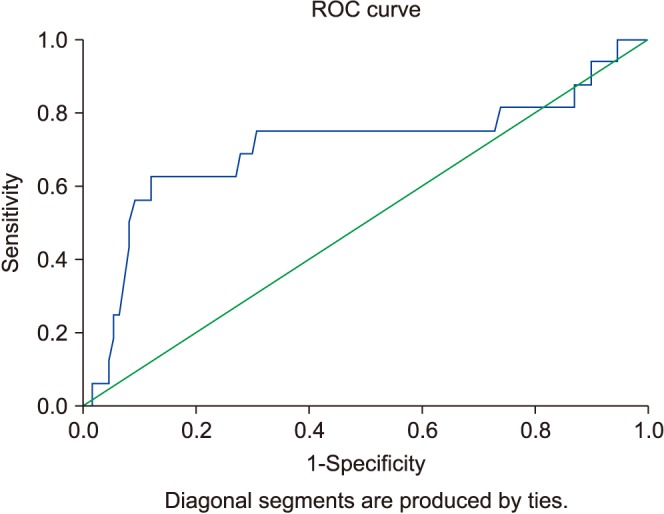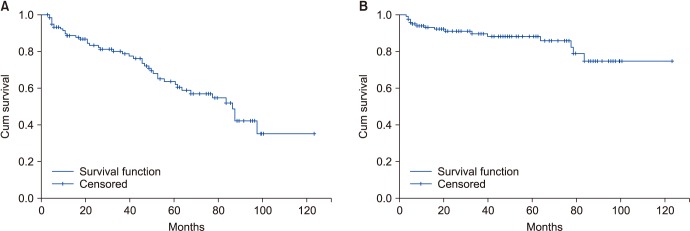1. La Vecchia C, Bosetti C, Lucchini F, Bertuccio P, Negri E, Boyle P, et al. Cancer mortality in Europe, 2000-2004, and an overview of trends since 1975. Ann Oncol. 2010; 21:1323–1360. PMID:
19948741.

2. Osbun N, Winters B, Holt SK, Schade GR, Lin DW, Wright JL. Characteristics of patients with sertoli and leydig cell testis neoplasms from a national population-based registry. Clin Genitourin Cancer. 2017; 15:e263–e266. PMID:
27594555.

3. Jemal A, Siegel R, Ward E, Hao Y, Xu J, Thun MJ. Cancer statistics, 2009. CA Cancer J Clin. 2009; 59:225–249. PMID:
19474385.

4. Nigam M, Aschebrook-Kilfoy B, Shikanov S, Eggener S. Increasing incidence of testicular cancer in the United States and Europe between 1992 and 2009. World J Urol. 2015; 33:623–631. PMID:
25030752.

5. Germà-Lluch JR, Garcia del Muro X, Maroto P, Paz-Ares L, Arranz JA, Gumà J, et al. Spanish Germ-Cell Cancer Group (GG). Clinical pattern and therapeutic results achieved in 1490 patients with germ-cell tumours of the testis: the experience of the Spanish Germ-Cell Cancer Group (GG). Eur Urol. 2002; 42:553–562. PMID:
12477650.

6. Wanderås EH, Tretli S, Fosså SD. Trends in incidence of testicular cancer in Norway 1955-1992. Eur J Cancer. 1995; 31A:2044–2048. PMID:
8562163.

7. Peyret C. Tumeurs du testicule. Synthèse et recommandations en onco-urologie [Testicular tumours. Summary of oncourological recommendations]. Prog Urol. 1993; 2:60–64. French.
8. Koshida K, Uchibayashi T, Yamamoto H, Hirano K. Significance of placental alkaline phosphatase (PLAP) in the monitoring of patients with seminoma. Br J Urol. 1996; 77:138–142. PMID:
8653285.

9. Mottet N, Rousmans S, Culine S. [Systematic review 2007: primary treatments of testicular germ cell tumors after radical orchydectomy]. Bull Cancer. 2008; 95:205–234. French. PMID:
18330045.
10. Ozer J, Ratner M, Shaw M, Bailey W, Schomaker S. The current state of serum biomarkers of hepatotoxicity. Toxicology. 2008; 245:194–205. PMID:
18291570.

11. De Ritis F, Coltorti M, Giusti G. An enzymic test for the diagnosis of viral hepatitis; the transaminase serum activities. Clin Chim Acta. 1957; 2:70–74. PMID:
13447217.

12. Botros M, Sikaris KA. The de ritis ratio: the test of time. Clin Biochem Rev. 2013; 34:117–130. PMID:
24353357.
13. Rawson NS, Peto J. An overview of prognostic factors in small cell lung cancer. A report from the Subcommittee for the Management of Lung Cancer of the United Kingdom Coordinating Committee on Cancer Research. Br J Cancer. 1990; 61:597–604. PMID:
2158808.
14. Stocken DD, Hassan AB, Altman DG, Billingham LJ, Bramhall SR, Johnson PJ, et al. Modelling prognostic factors in advanced pancreatic cancer. Br J Cancer. 2008; 99:883–893. PMID:
19238630.

15. Sobin LH, Gospodarowicz MK, Wittekind C. TNM classification of malignant tumors. In : Sobin LH, Gospodarowicz MK, Wittekind C, editors. UICC International Union Against Cancer. 7th ed. Oxford: Wiley-Blackwell;2009. p. 249–254.
16. Secil M, Altay C, Basara I. State of the art in germ cell tumor imaging. Urol Oncol. 2016; 34:156–164. PMID:
26215982.

17. Masterson TA, Shayegan B, Carver BS, Bajorin DF, Feldman DR, Motzer RJ, et al. Clinical impact of residual extraretroperitoneal masses in patients with advanced nonseminomatous germ cell testicular cancer. Urology. 2012; 79:156–159. PMID:
22202548.

18. Haugnes HS, Laurell A, Stierner U, Bremnes RM, Dahl O, Cavallin-Ståhl E, et al. High-dose chemotherapy with autologous stem cell support in patients with metastatic non-seminomatous testicular cancer - a report from the Swedish Norwegian Testicular Cancer Group (SWENOTECA). Acta Oncol. 2012; 51:168–176. PMID:
22175254.

19. Fizazi K, Culine S, Kramar A, Amato RJ, Bouzy J, Chen I, et al. Early predicted time to normalization of tumor markers predicts outcome in poor-prognosis nonseminomatous germ cell tumors. J Clin Oncol. 2004; 22:3868–3876. PMID:
15302906.

20. Panchuk RR, Skorokhyd NR, Kozak YS, Lehka LV, Chumak VV, Omelyanchik SN, et al. Antioxidants selenomethionine and D-pantethine decrease the negative side effects of doxorubicin in NL/Ly lymphoma-bearing mice. Croat Med J. 2016; 57:180–192. PMID:
27106359.

21. Tan X, Xiao K, Liu W, Chang S, Zhang T, Tang H. Prognostic factors of distal cholangiocarcinoma after curative surgery: a series of 84 cases. Hepatogastroenterology. 2013; 60:1892–1895. PMID:
24719923.
22. Warburg O. On respiratory impairment in cancer cells. Science. 1956; 124:269–270. PMID:
13351639.

23. Walker-Samuel S, Ramasawmy R, Torrealdea F, Rega M, Rajkumar V, Johnson SP, et al. In vivo imaging of glucose uptake and metabolism in tumors. Nat Med. 2013; 19:1067–1072. PMID:
23832090.

24. Dorward A, Sweet S, Moorehead R, Singh G. Mitochondrial contributions to cancer cell physiology: redox balance, cell cycle, and drug resistance. J Bioenerg Biomembr. 1997; 29:385–392. PMID:
9387099.
25. Fantin VR, St-Pierre J, Leder P. Attenuation of LDH-A expression uncovers a link between glycolysis, mitochondrial physiology, and tumor maintenance. Cancer Cell. 2006; 9:425–434. PMID:
16766262.

26. Bezan A, Mrsic E, Krieger D, Stojakovic T, Pummer K, Zigeuner R, et al. The preoperative AST/ALT (De Ritis) ratio represents a poor prognostic factor in a cohort of patients with nonmetastatic renal cell carcinoma. J Urol. 2015; 194:30–35. PMID:
25623738.

27. Wang H, Fang K, Zhang J, Jiang Y, Wang G, Zhang H, et al. The significance of De Ritis (aspartate transaminase/alanine transaminase) ratio in predicting pathological outcomes and prognosis in localized prostate cancer patients. Int Urol Nephrol. 2017; 49:1391–1398. PMID:
28550473.

28. Gorgel SN, Kose O, Koc EM, Ates E, Akin Y, Yilmaz Y. The prognostic significance of preoperatively assessed AST/ALT (De Ritis) ratio on survival in patients underwent radical cystectomy. Int Urol Nephrol. 2017; 49:1577–1583. PMID:
28669104.

29. Ha YS, Kim SW, Chun SY, Chung JW, Choi SH, Lee JN, et al. Association between De Ritis ratio (aspartate aminotransferase/alanine aminotransferase) and oncological outcomes in bladder cancer patients after radical cystectomy. BMC Urol. 2019; 19:10. PMID:
30678673.

30. Nishikawa M, Miyake H, Fujisawa M. De Ritis (aspartate transaminase/alanine transaminase) ratio as a significant predictor of recurrence-free survival in patients with upper urinary tract urothelial carcinoma following nephroureterectomy. Urol Oncol. 2016; 34:417.e9–417.e15.











 PDF
PDF ePub
ePub Citation
Citation Print
Print



 XML Download
XML Download